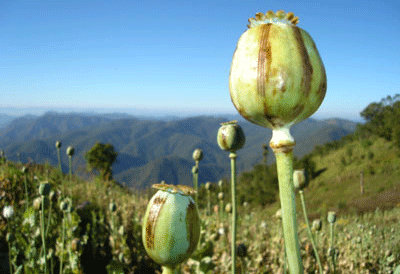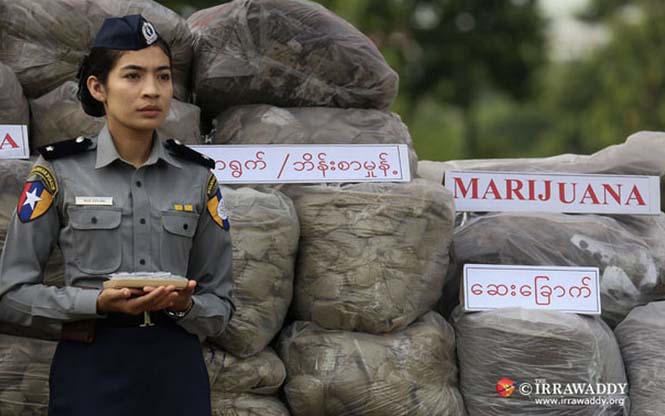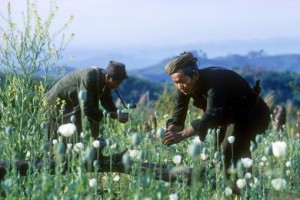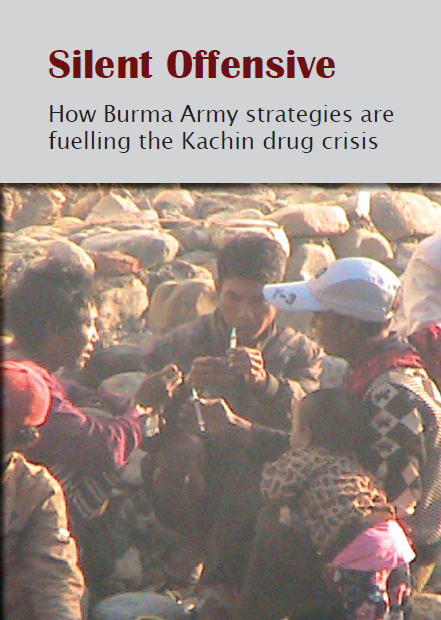Posts Tagged ‘United Nations Office on Drug and Crime’ (8 found)
Opium Production in the Golden Triangle Continues at High Levels, Threatening Regional Integration
Opium poppy cultivation in Myanmar and Lao PDR rose to 63,800 hectares (ha) in 2014 compared to 61,200 ha in 2013, increasing for the eighth consecutive year and nearly tripling the amount harvested in 2006, according to the Southeast Asia Opium Survey 2014 – Lao PDR, Myanmar. […]
• • •Burma Army Continues to Use the Drugs Trade as a Weapon of War
 A new report by Kachin Women’s Association – Thailand (KWAT), “Silent Offensive: How Burma Army Strategies are Fuelling the Kachin Drug Crisis” outlines the severity of the drug problem in northern Burma as well as the complicity of the government in the trade. The report shows how the government is using opium-growing militia forces in its operations against the Kachin Independence Army (KIA) as part of a deal in which these militias are given free rein to produce and sell heroin and other narcotics.
A new report by Kachin Women’s Association – Thailand (KWAT), “Silent Offensive: How Burma Army Strategies are Fuelling the Kachin Drug Crisis” outlines the severity of the drug problem in northern Burma as well as the complicity of the government in the trade. The report shows how the government is using opium-growing militia forces in its operations against the Kachin Independence Army (KIA) as part of a deal in which these militias are given free rein to produce and sell heroin and other narcotics.
Thus, as the report points out, it is members of either Burma Army controlled Border Guard Forces (BGF) such as the New Democratic Army – Kachin (NDAK), a splinter group of the Kachin Independence Organization (KIO) that became a BGF in 2009, or People’s Militia Forces (PMF) that are heavily involved in offensives against the KIO. Land that is taken by the Burma Army and its proxy forces is then allocated to BGFs/PMFs to utilize however they like. This is often opium cultivation, heroin production and methamphetamine production. To make matters worse these are areas under which the KIO had previously been involved in anti-drug activities but since BGFs or PMFs have taken over, opium cultivation has increased greatly in areas such as Nampaka in northern Shan State and Chipwi in Kachin State […]
• • •Silent Offensive: How Burma Army Strategies are Fuelling the Kachin Drug Crisis
This report, based on interviews with Kachin drug users, their family members, drug sellers, and community leaders in eight townships of northern Burma, paints a disturbing picture of the drug crisis in Kachin areas. It shows how the renewed conflict against the Kachin Independence Army (KIA) since June 2011 is fuelling drug production and worsening existing drug abuse among Kachin communities. […]
• • •Another Great year for Burma’s Drug Trade
 It is of no surprise that the latest report from the UN’s Office for Drugs and Crime (UNODC) on synthetic drugs finds that methamphetamine production in Burma continues to rise. Burma is already the second highest producer of opium in the world after Afghanistan and the fact that production rates of both opium and methamphetamine are increasing year on year points to a more complex picture than simply increase in demand. Poverty, displacement, conflict, and government complicity are all factors in this miserable state of affairs.
It is of no surprise that the latest report from the UN’s Office for Drugs and Crime (UNODC) on synthetic drugs finds that methamphetamine production in Burma continues to rise. Burma is already the second highest producer of opium in the world after Afghanistan and the fact that production rates of both opium and methamphetamine are increasing year on year points to a more complex picture than simply increase in demand. Poverty, displacement, conflict, and government complicity are all factors in this miserable state of affairs.
According to the UNODC report, “2014 Global Synthetic Drugs Assessment – Amphetamine-type Stimulants and New Psychoactive Substances,” that was released in Tokyo, Japan on 20 May 2014, seizures of methamphetamine in Asia have tripled over the past five years. The report highlights how most of the methamphetamine seized in Thailand, Bangladesh, and Burma itself, originates in Burma, while Jason Eligh, country manager for UNODC Burma states that, “according to expert perception, a large share of methamphetamine pills seized in China in 2012 originated from Myanmar.” This report complements a UNODC report on opium production in Burma released six months ago that showed a 26% increase from the year before, the highest recorded levels since monitoring began in 2002 […]
• • •Asia and North America Drive Global Methamphetamine Seizures to Record Levels, UNODC Reports
Tokyo (Japan), 20 May 2014 – Growing demand in East and Southeast Asia is leading to an expansion of global production and trafficking in methamphetamine and new psychoactive substances, according to a UN Office on Drugs and Crime (UNODC) report released here today […]
• • •2014 Global Synthetic Drugs Assessment – Amphetamine-type Stimulants and New Psychoactive Substances
 Growing demand in East and Southeast Asia is leading to an expansion of global production and trafficking in methamphetamine and new psychoactive substances, according to the report 2014 Global Synthetic Drugs Assessment – Amphetamine-type Stimulants and New Psychoactive Substances, a report produced by UN Office on Drugs and Crime (UNODC). The launch of the report was hosted by Japan’s Ministry of Foreign Affairs […]
Growing demand in East and Southeast Asia is leading to an expansion of global production and trafficking in methamphetamine and new psychoactive substances, according to the report 2014 Global Synthetic Drugs Assessment – Amphetamine-type Stimulants and New Psychoactive Substances, a report produced by UN Office on Drugs and Crime (UNODC). The launch of the report was hosted by Japan’s Ministry of Foreign Affairs […]
Latest Opium Cultivation Figures for Burma Maintain Worrying Status Quo
 A UN Office on Drugs and Crime report released last week reveals that opium cultivation has increased in Burma for the sixth consecutive year. In 2012 there will be an estimated 690 tons of opium grown in the country, a 17% increase from last year and double that of six years ago.
A UN Office on Drugs and Crime report released last week reveals that opium cultivation has increased in Burma for the sixth consecutive year. In 2012 there will be an estimated 690 tons of opium grown in the country, a 17% increase from last year and double that of six years ago.
Poverty, caused by the inability of people to participate in sustainable livelihoods due to armed conflict and repression is a causal factor for this increase in opium cultivation. There has been much focus on Burma over recent political developments, the release of political prisoners and the easing of media restrictions. However, there has been very little focus on the lack of alternatives for people living in the conflict areas of Shan and Kachin States, where the majority of opium production occurs. There is a direct link between ongoing conflict and opium cultivation. “There is no question that there is a strong connection between the conflicts in the country and the most immediate sources of revenue to purchase weapons, and in many instances this is both opium and heroin and methamphetamine pills,” says Gary Lewis, the United Nations Office on Drugs and Crime regional representative […]
South-East Asia Opium Survey 2012: Lao People’s Democratic Republic and Myanmar
“The opium numbers continue to head in the wrong direction”, said Gary Lewis, UNODC Regional Representative for East Asia and the Pacific. “However, we have seen more progress on responding to the root causes of opium cultivation in the past year than we have in the past decade. The international community must now ask ‘how can we help?’, and provide resources towards a solution.”
• • •









 All posts
All posts